With its parallel tracking arm and LED lit platter, the £4700 Pre Audio GL-1102N Turntable hailing from Poland certainly looks a little out of the ordinary. Will it prove to be just that or something extraordinary? Janine Elliot finds out for Hifi Pig.
There are not many times in my work as a reviewer that I get excited. There are so many wannabees out there with claims to be the best at everything. I have heard it all before from manufacturers claiming that their new components or technologies make everything in the past to be…well, history.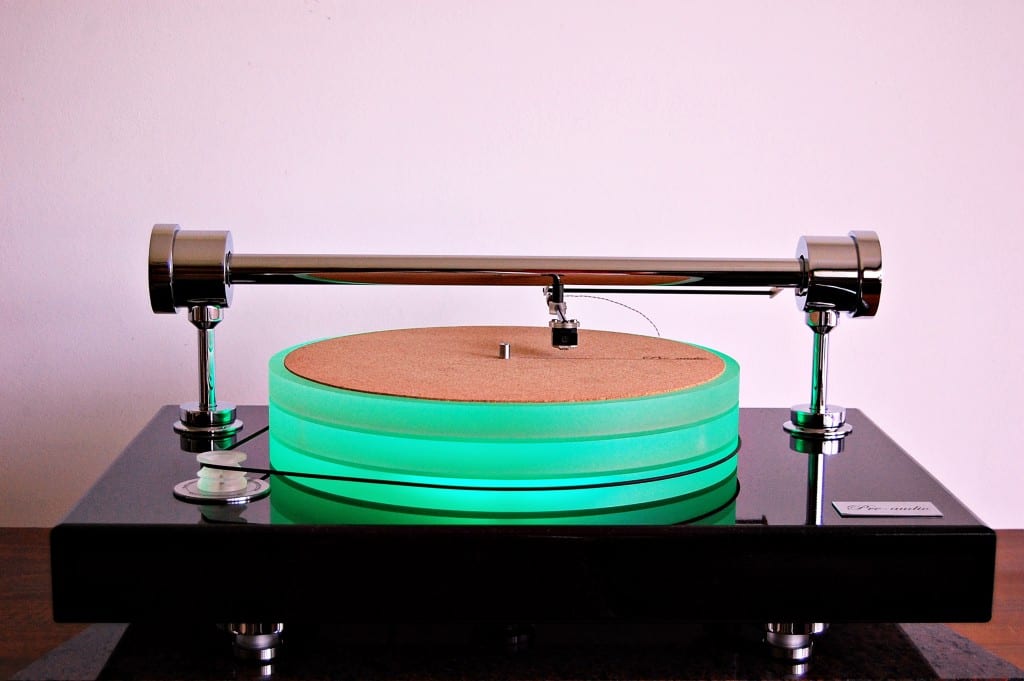
To be sent a 60kg granite turntable whose 65mm resin platter lights up in multiple colours was not going to be a good start for me, but boy was I surprised. At £4700 including Audio Technica AT33sa MC cartridge, the Polish Pre Audio GL-1102N, distributed in the UK by GPoint Audio, is one of 6 turntables in a range starting at just over £1k to the ATM-1401 with AT ART 9 cartridge at £7900, that all but one feature parallel tracking arms. The turntable up for review here is second from top in the list of players from Daniel Prendecki, a master craftsman from Nysa, Poland in his early 30’s who has only been manufacturing turntables since 2009. He was quick to realise that unless you have a parallel tracking arm like The CartridgeMan or Rabco SL-8E, turntables such as Harman Kardon ST7, Revox B795 or the gorgeous B&O Beogram 4000 , or indeed the very first Edison, you will always get lateral tracking error, and hence some distortion. Therefore all his machines are designed this way to get an ideal geometry, and provide a more accurate reading of the record and consequently more detail.
The early versions of parallel tracking arms relied on lights or mechanics or a very noisy air pump to allow the cartridge to move slowly across the groove without rubbing against the groove as it forced its way to the centre. If you were to read my recent Retrobyte column about distortion in vinyl you would understand my sheer joy at hearing a turntable play records just the way they were recorded from the Neumann VMS-70 or 80 cutting lathe. Only the Nackamichi TX1000 self-centring turntable with a parallel tracking arm would remove all distortion and speed fluctuation caused by non-centred record pressings, but having a conventional turntable with parallel tracking arm would at least be the nearest best thing to playing a record as it was supposed to be heard. 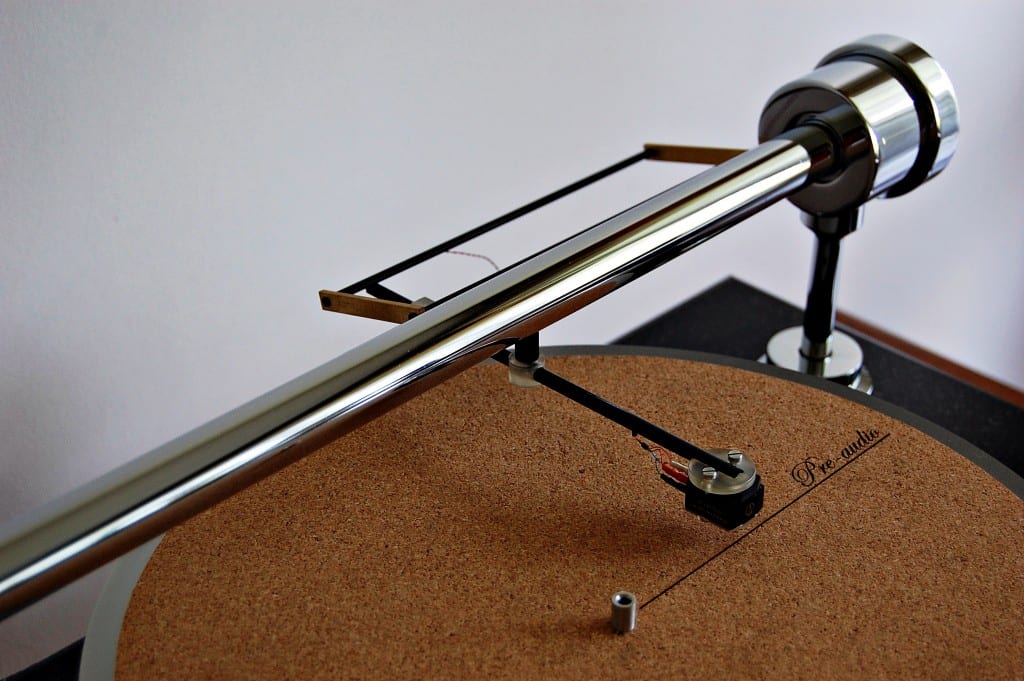
Air is probably the best solution removing any friction on the rail carrying the arm/cartridge, and the arm itself needs to be as light as possible to make this happen even more smoothly. On the hand-made-to-order Pre Audio GL-1102N this is certainly the case, with the 95mm arm being a very thin hollow carbon fibre. The cable is lightweight Litz and the thin diameter air cable means no hindrance in its move across the record. The rod that the arm assembly moves across is supported at both ends, unlike the cheaper models in the range, so this does make it look a little more functional than beautiful, but does make it very sturdy. The arm is lifted up and down via a rod pulling own on the rear of the arm pivot point. All very simple, but very effective. There is no damping of the cueing of the arm, so a little care is needed to do it gently, though the big size of the cueing lever on the right means this will be done slowly anyway.
This turntable and arm system ushered quality in terms of materials and design. Only trying to find a suitable stand that could take the weight of this behemoth was the problem. The granite plinth is available in varying finishes, though the grey/black version up for review has the smaller and tighter “particles” and gives the best sound. The AC motor is floating, and surprisingly just relies on a steady power supply rather than some fancy speed stabilising technology. The supplied AC/DC adaptor is for the three LEDs that light up this beast, allowing you to choose the mood of lighting to suit that of the music, whether one of the 8 colours or discotheque-style fading between them, all operated via the supplied remote control.
The outer-platter belt drive turntable was very quiet in operation and got up to speed in good time. The only noise was a very quiet and well damped pump, in its own box complete with a pressure gauge, to show how much air it is putting out. The long cabling and tubing means it can be placed in another room if required, being operated via a rocker switch on the rear of the turntable itself. The turntable comes with a heavy record clamp with a spirit level built in to the centre (though I relied on my own more accurate spirit level when setting up).
I was quite sceptical about the simplicity of the motor system but the lack of any audible wow from my perfect-pitch sensitivity (the turntable rated at 0.01%, and +/-0.2% speed variance) made my old ‘Classics for Pleasure’ Rachmaninov Piano concerto No.2 (Martino Tirimo, Philharmonica Orchestra Yoel Levi) highly emotional and exact. I always prefer strong motors and outer-belt driven platters, and this one is a heavy triple-layer platter and ensured stable revolving of the turntable. The amount of space in this recording, both left and right and front to back was quite startling. This was just as the record had been etched onto the master. Consequently there was no distortion from the cymbals bashing away in the middle of the 3rd movement, and on side two with his Variations Rhapsody on a Theme of Paganini the pianist’s deep breaths were highly audible. I was there in the audience, and these being two of my favourite works I was crying. Really!! 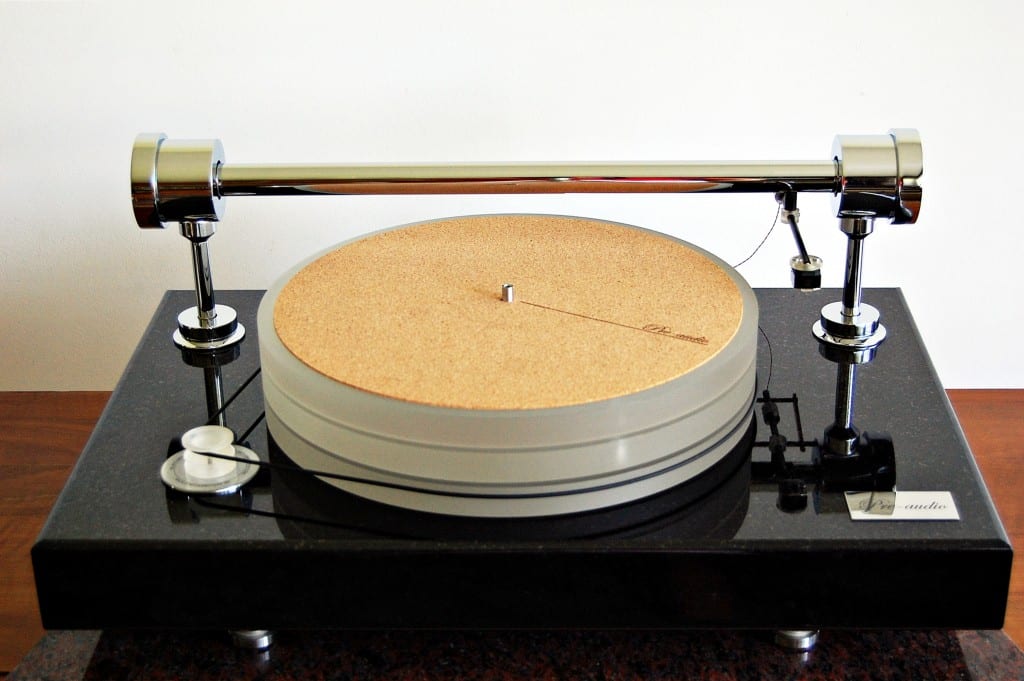
Turning to the excellent Queen Collection, via Krell/MFA/Manley and Graham Audio LS5/9s, it was like sitting in the studio in front of Freddie. “Jazz” has a wealth of international flavour, not least because it was their first album recorded outside of the UK, and that the cover design was inspired by a painting on the Berlin Wall, but also in the variety of different styles of music and instrumentation, whether Indian Sitar or American Blues. Fat Bottom Girl had smoothness but accuracy that made it like a Rodgers and Hammerstein full music score, if perhaps a little sedate. The long decay from piano and guitar at the end of ‘Jealousy’ was longer than I remembered it, and Bicycle Race – inspired by seeing the Tour de France whilst in Montreux – had a beautifully realistic piano showing no lack of composure. This turntable was so accurate that in a way the music became too easy. Pink Floyd “The Division Bell” had clarity and depth that made me relax and want to breath in all the notes. The AT33sa with its Shibata stylus and boron cantilever is a dark sounding cartridge with an excellent delivery of the deepest bass, and a few times I did feel I needed better control from the arm to carry it through successfully. Many will know my love of the Townshend Rock with its trough/paddle system to control those deepest lows. But that said, this cartridge/turntable duo made the music speak with control I have only heard in top end turntables. The soft bass drum after the first minute of the first track of side two was tight and powerful, and quite simply beautiful.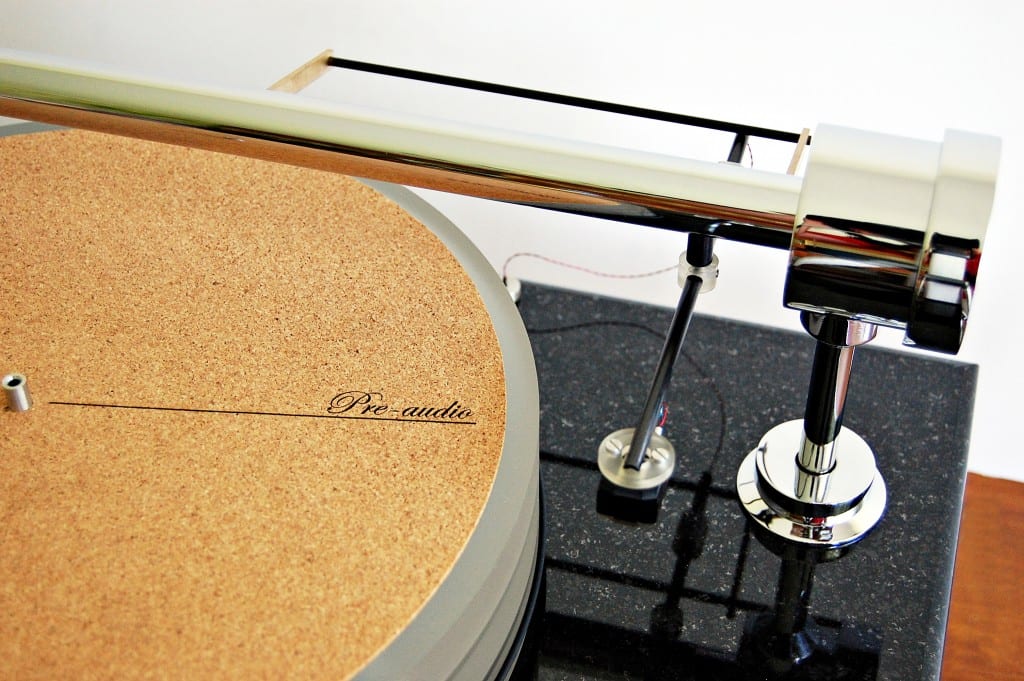
Dire Strait’s Mark Knoffler “You Can’t Beat the House” (Get Lucky) had an enlarged atmosphere with vocals, drums, honky-tonk piano and ride cymbals clearly placed in 3D in front of me. The cymbals were particularly clear. There was no worry about cartridge distortion due to badly set up bias compensation or wrong angle of the elliptical cartridge to the groove. Cartridge set up was as easy as pi (sic). “Cleaning my Gun” had power but immense clarity amid the powerful drumming, but nothing was rushed. No, this turntable was careful with all that it played.
Saint-Saen’s Organ Symphony No3 (Serge Baudo London Philharmonic Orchestra) is a detailed and complicated work with strings up against brass and woodwind, and the Pre Audio gave a polished performance, with the deep pedal organ in the third movement taking off with a control only my Wilson Benesch Torus subsonic generators could pull off perfectly. This might not be a polished performance by the orchestra, but I enjoyed listening more than with any other turntable I have put it up against. This was the orchestra in my living room, and every nuance from the orchestra was picked up with control. The second movement is filled with violins conversing with cellos and violas and the organ quietly muttering in the background. This was good. Scratches in the record just didn’t matter, indeed they seemed quieter.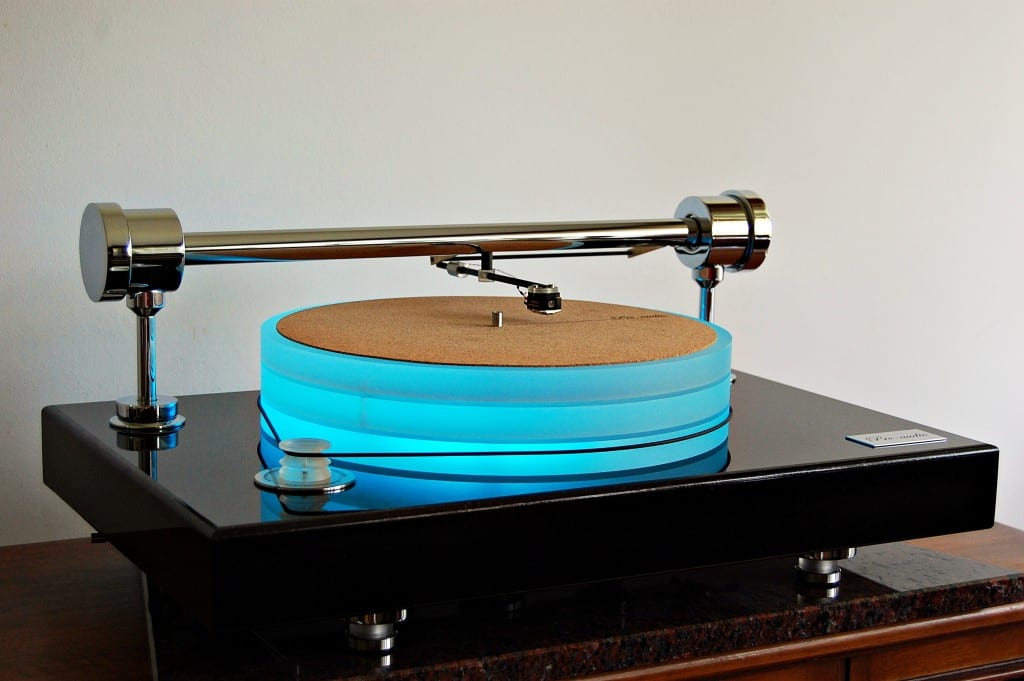
Now you might think that I have nothing negative to say about this turntable, but this is not true. I love the idea of solid plinths (my early marble Trio and Garrard 301 homemade solid platter gave an amazingly good bass end) but what it does mean is that any noise getting past the rubber feet will make their way to the cartridge (albeit in this case not a worrying amount, since the air bearing dampens most of it), and it does mean that a sensible and strong stand is a necessity, which could mean almost another £1000 on the price. Also, the three translucent platters making up the tower are held together with inbuilt magnets and ball bearings, meaning you need to be careful when cleaning the record prior to playing so that you don’t get too carried away as the 3-layered plinth might come apart. Also, when removing the record, the cork top platter can come off with the record if there is static on the record. Perhaps the cork should be glued to the top platter, though of course it does mean I can use an alternative, such as the Statmap. The cork platter has a line marking across it from the spindle making that cartridge alignment even easier. The spindle for the record is only affixed to the top ‘layer’ of platter, reducing noise from the bearing, which only connects with the first, lowest platter. This turntable is therefore very quiet.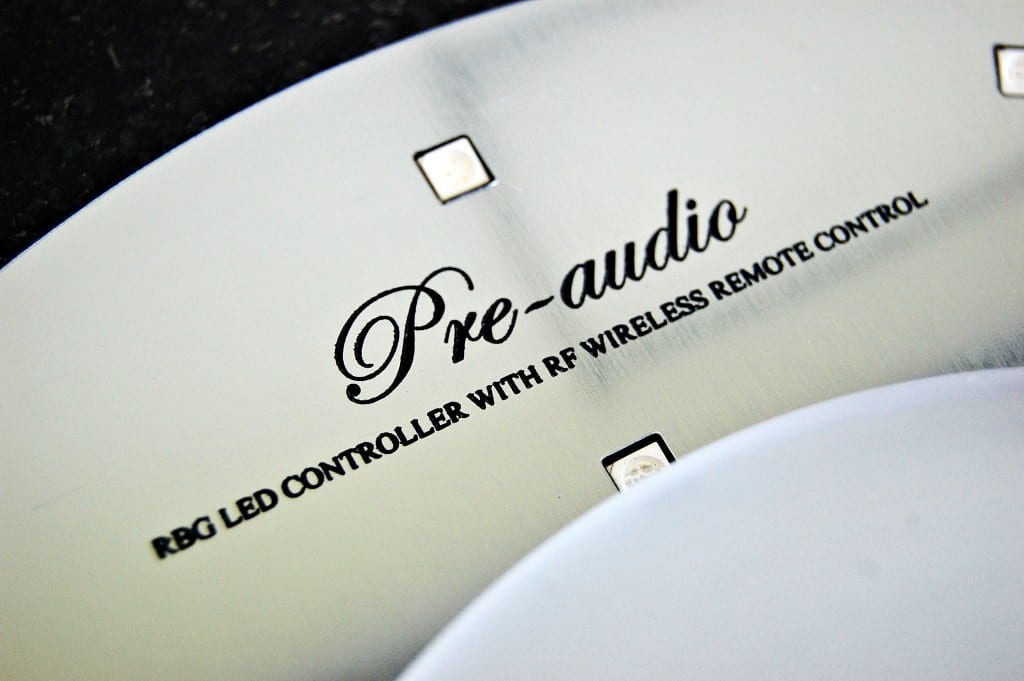
CONCLUSION
I have heard many turntables in my life, indeed I already own 13, all with their plus and minus points, but this turntable, complete with the capable AT 33Sa cartridge gave me more fun than I have had since unpacking my very first Fidelity record player at the age of 9 years. Just like me, Daniel Prendecki could see there were imperfections in all of them which led him to start making his own products.
This turntable was not only a pleasure to play but it was also entertaining for all those who came to visit, having never seen an unusual looking turntable that lights up as well.
For the price this is a quite stunning offering, and being so impressed this will now be my turntable number 14.
Sound Quality: 9.2/10
Value for Money: 8.8/10
Overall: 8.87/10
Price at Time of Review £4700
Pros:
Sonic supremacy
Parallel arm
Competitive pricing
Very easy set up
Looks
Lights up
Cons:
At 60kg requires a strong table
The top platter can become separated from below if you are not careful
Janine Elliot

























































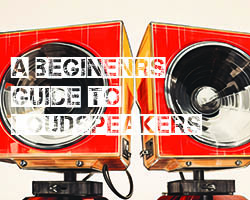


























































































































































You must be logged in to leave a reply.